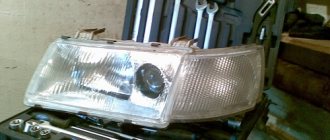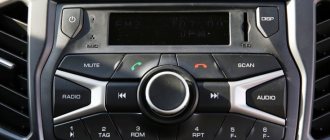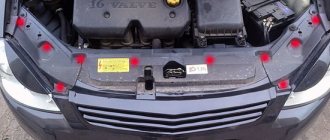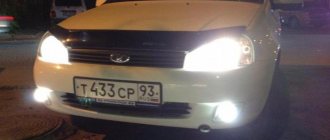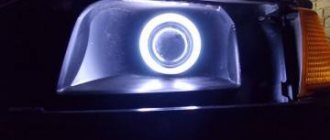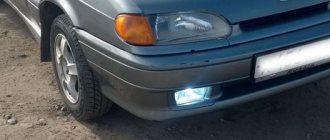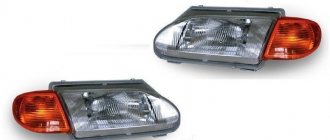Tuning Lada Vesta: interior, exterior and options for modifying the interior and engine (150 photos + video)
We would like to share our opinion on the topic of tuning.
These are our thoughts and they may differ from your ideas. In the article we will describe the topic of refining the sedan, Lada Vesta tuning outside and inside! I think many car owners have asked the question: “How to optimally pump up a car with minimal investment?” Let’s find out. First, let's understand what makes sense to put on the car. To make the front of the car more aggressive, I would choose the Lada Vesta Xmug front bumper. This is an interesting and practical bumper; it does not interfere with driving on our rough roads. Prices for it start from 5,400 rubles. I installed door sill covers in the form of yarplast (prices from 650 rubles), which will greatly increase the practicality of the car, making it easier to clean the interior. We will try to do all the tuning ourselves as much as possible. This saves money, and who doesn’t like to tinker with their favorite car for a couple of hours in the garage?)
The next stage would be improvements to the optics, headlights and taillights - an essential part of the car improvement process. All auto parts would be bought at a regular tuning store; there shouldn’t be much difficulty in finding them. Let's imagine that the car is black, and I think that the elements should be installed in black. A white car has a choice between white elements or individual black inserts. The decision to “upgrade” the Lada comes after realizing that the car’s stock characteristics are extremely lacking. The car has fairly calm, perhaps even “family” lines, and not the highest dynamics. I think the main popularity of tuning for Vesta is connected with this. Last on the list, but not least in importance would be 18-inch wheels; they look nice on the car. The first stage of refining the Lada has been completed, we need to start something large-scale.
Updated Lada Vesta: what will change and when to expect?
In the long term, Vesta has already signed a verdict: according to the adopted development strategy of the Renault Group, by 2025 Lada cars will completely switch to the corporate-wide modular platform CMF-B. This means that AVTOVAZ will abandon the Granta, Niva and Vesta platforms. Moreover, the plant has already given explanations that modernizing even the relatively modern Vesta trolley is simply unprofitable, and it is easier to immediately switch to the ready-made Renault architecture. However, Vesta will remain on the assembly line for about four more years, so it will still have a restyling. Camouflaged prototypes of updated sedans and station wagons are increasingly seen on the roads, and we found out some details about these cars.
Vesta is still the most expensive model under the Lada brand, so the focus of restyling is on a new perception of the car. The design will change: according to preliminary information, expensive versions will have LED headlights and taillights. The quality of finishing materials in the cabin will be improved, the top version will have a media system with a larger screen (with “portrait” orientation) and expanded functionality.
Vesta will be the first production Lada with a virtual instrument cluster, and the climate control unit with three rotating knobs and displays built into them will be borrowed from the Renault Arkana and Duster crossovers. The restyled Cross versions will additionally acquire the Ride Select system, which is already known from the XRAY Cross hatchback: using the washer on the center console, you can select the off-road or sport mode of the driving electronics.
There will be no changes under the hood - at least at the start of sales. Vesta will retain the VAZ engines 1.6 (106 hp) and 1.8 (122 hp) paired with a manual transmission and the Renault 1.6 engine (113 hp) with a CVT. The “warmed-up” Lada Vesta Sport with a forced 1.8 engine (145 hp) will also remain in service, and here’s important news: in addition to the sedan, a Sport station wagon will finally appear! Moreover, this Vesta SW Sport was certified back in 2022 along with the sedan, but the plant did not dare to make it into serial production.
According to Autoreview, the updated Vesta will be presented in March 2022. And, sure enough, it will become noticeably more expensive. After the next price increase, which AVTOVAZ carried out on September 1, the base Vesta costs 784 thousand rubles, and the maximum recommended price exceeds 1.2 million rubles. By the way, in August Vesta became the best-selling Lada: 6882 cars, although this is 19% less than in the same month of 2020. The cheaper Granta gave way (5007 units, minus 52%). In both cases, the decline was due to a reduction in output due to a shortage of semiconductors.
Installing the engine cover
We hope it will be simple. The lid fits without any problems, and we put it in place. I have one question for you. Who knows the answer, write in the comments. One person working at an official dealer said that they stopped installing such covers. They seem to be fraying some kind of wire. I looked and looked into all the cracks after installation. All wires are insulated or corrugated.
I didn't see any wires touching the cover anywhere. Who knows the catch, write in the “comments”, maybe I just didn’t see where this place is.
The main disadvantages of the Lada Vesta SV that can be corrected
Vesta SW is the car that Russian drivers have been waiting for so long. But initially it turned out to have quite a lot of problem areas and shortcomings. Naturally, taking radical measures, the automaker corrected most of them. But the drivers themselves have something to work on.
There are some nuances that you will have to work on yourself:
- The first thing you need to pay attention to is the cabin air intake. It is located in front of the windshield under the windshield. Its huge disadvantage is that it is absolutely not covered with anything - there is no mesh or other structures on the rectangular hole that could trap debris and leaves. As a result, everything ends up in the filter, and it quickly becomes clogged. Some craftsmen solve this by installing a homemade frame with a mesh made from a plastic window. The frame itself is cut from an ordinary plastic motor oil canister.
- Over time, the front panel begins to rattle and creak while driving. In this case, the problem lies in the instrument cluster wells, mounts, housings, wires, mounting blocks, air ducts, trim, and so on. Some Vesta owners solve the problem with the help of special anti-squeaking products, which can be purchased at car stores. Naturally, you will have to work hard - you will need to disassemble half of the front part of the cabin and treat all places with this product, tighten the casings and bolts.
- Often there are uneven gaps between the body and the hood. Sometimes they are very large, so they interfere with opening it or disable the lock. You will have to fix it yourself by adjusting the stop and lock. You will most likely need to use a file.
- The factory does not install branded hood gas struts, but dealers have them. But how necessary this is is for everyone to decide for themselves.
- The fuel filler door does not lock and there is no protection in the filler neck. The only thing that will help here is to buy a plug with a key. The ideal option would be a model from Logan.
- In the rear door, water penetrates into the wiring harness block in the area of the hole for the guide strip. You will have to remove the cover, use a rag or soft washer and mastic around the guide. Then everything is installed in place.
Installing the hood seal
The rubber band from the factory is installed only in the center, and there is nothing at the edges. Why couldn't it be done around the entire perimeter? The car would cost 500 rubles more, but it would be clean under the hood!
Let's glue some 2mm construction sealant here.
But first we degrease the surface with a special degreaser, and then warm it up. After that, everything is easily glued and looks like this.
There is nothing complicated, just take it and glue it. The main thing is to degrease thoroughly. The result is great. After this, it will be much cleaner under the hood. We will put all minor issues in order.
Connecting electronics
- Route the wiring coming from the right PTF inside the box.
- The wiring into the car interior is routed through the standard hole, which is located near the pedals, and is fed into the button. The gasket must be placed over the steering shaft.
- The biggest disadvantage of installing foglights yourself is the indicator not working, however, there is a solution to this problem. In order to connect the light on indicator on the instrument panel, you need to remove the glove compartment and find the TsBKE there - the central unit of body electronics. In the “S1 Black” connector you need to find the 5th pin in the bottom row on the left and add a +12V wire there. After this, the indicator should light up when the PTF is turned on.
- We take power for the relay through the battery using a fuse.
- We connect “plus” from the side light fuse, marked F6 or F7. You can also use a cigarette lighter for this.
- The relay can be installed both under the hood and inside the cabin - there is no difference.
- Now all that remains is to hide all the wires and check the functionality of the installed headlights.
It is also possible to connect using a standard switch located under the steering wheel in the “Comfort” and “Standard” configurations. To do this, you will need a pulse relay, and all connections are made directly in the interior mounting block.
The main advantage of this method is that installation does not require disassembling the steering shaft housing below and the center console, and wiring can be used to a minimum. In addition, in this case it will be possible to turn on the PTF simultaneously with the dimensions and high beam.
General tuning Vesta SV
In terms of general tuning, Vesta, like many other cars, gives you the opportunity to go wild. If you have the desire, time, opportunity and money, then you can radically change your car by performing the following operations:
- installing linings, deflectors, racks, protection, spoilers;
- carry out tuning of the power unit, interior, brakes, body, transmission, suspension;
- replacing the seat upholstery
- by reducing the brightness of the standard MMC backlight and so on.
But to start changing something, it’s worth figuring out whether there is any point in certain modifications. When working with a sedan, you can change its appearance by replacing the installed bumper with the Vesta Xmug model. From the front it will become more aggressive and sporty, this does not interfere with driving even on bad roads, so it is a practical and very interesting option. The cost of modification is about 5.5 thousand rubles. You can increase the practicality of a car with the help of yarplast type door sills, the cost of which starts from 650 rubles. Installing them makes cleaning the machine easier. For many drivers, improving optics is a must, as is installing 18-inch wheels.
But these are all fairly simple solutions. But more radical changes require a serious approach:
- Door sill, bumper and external styling spoiler. The main changes here are only visual. The body kit costs adequate money, but you need to start with yarplasts. Installation of Xmug bumpers makes the appearance of the model even more interesting and vibrant.
- Working with the salon. There are many more questions here than with appearance. Poor sound insulation and impractical materials constantly remind of themselves. The fewest questions arise about the dashboard. Many people recommend replacing the base armrest right away, but it is inexpensive. It is better to install rubber pads on the carpet.
- Turbine. This cannot be done without technical improvements. Without such tuning, all changes will be incomplete. The first thing you need to do is install the turbine; here you will need to contact specialists to install the part and configure the option. It is recommended to purchase a complete kit at once.
Finally, you can work on the exhaust system, but this is only for those who love the “animal roar”. By removing the catalyst, the sound becomes bright and aggressive. But sometimes it is necessary to work with the system if the exhaust “howls”. This indicates that the corrugation has deteriorated and a resonator with a reinforced element will need to be installed. And the spider exhaust manifold will help make the sound as pleasant as possible.
Choosing PTF for Vesta
If you still decide to save money and install fog lights yourself, you should start by choosing reliable and high-quality headlights.
There really are a lot of options, but good manufacturers put a hefty price tag on their products. And yet it is lower than installing PTF at the dealer.
Before purchasing, be sure to check with specialists about the compatibility of the headlights with your car. This need not be done if the article numbers match the original PTF.
Which headlights to choose - xenon, LED, halogen - is everyone’s business. We recommend giving preference to foreign brands:
- Osram;
- Wesem;
- Hella;
- MTF Light, etc.
When purchasing, be sure to check the integrity of the packaging and the headlights themselves.
Please note that if you have a “luxury” package, then you should think not about re-equipping the entire system, but about replacing diodes and lenses: this will be much cheaper.
Turbine
Now the most interesting part is the technical part. Without these modifications, the tuning of our Lada Vesta cannot be considered complete. The first step in increasing power was the installation of a turbine. Here, the modest skills of a beginner are no longer enough; you would have to pay a tidy sum for installing and configuring this option. I immediately bought the entire kit, which also includes injectors, piping, spark plugs, cooler, hoses, hardware, and a turbocharger. If you don’t stop at the turbine, as they say, just walk away.
Installation of fog lights on Vesta
Difficulties in installation are due to the fact that the Vesta electronics system is fundamentally different from previous Lada models, like the Priora or Granta.
Also take into account the fact that the signal to turn on the headlights comes from the steering column lever to the EMM unit, and only then to the headlights themselves.
The headlights-on indicator operates from the CAN bus signal. This is provided in a “luxury” configuration, and installing a similar system will be expensive.
To reduce the cost and ease of installation, we recommend avoiding significant interventions in the electronics. It is enough to get by with installation using a separate circuit and turning it on using a button rather than a lever.
Equipment:
- Fog lights;
- Power button;
- Relay 4-pin;
- Fuse 16A;
- 5-6 meters of wiring;
- 2 brackets for fastening;
- Facing panels for Lada Vesta 2 pcs.
This entire kit costs an average of 5-6 thousand rubles - it all depends on the selected headlights.
Engine modifications
The Vesta line offers three power units, two 1.6 liters and one 1.8 liter 87/106/122 hp. With all options, there will be no problems for a specialist. The process is quite long, but the result will please you. The main idea is chip tuning of the engine and installation of different camshafts. This will significantly increase power from 106 hp to 177 hp. Installing LGS and STI camshafts makes it possible to increase dynamics without changing speed. The car becomes more dynamic.
Some owners note that the electronic pedal sometimes works slowly, so they are advised to modify it themselves. For different modifications, the solution to the problem will be different. In one case, you will need to slightly file the travel limitation protrusion, and in the second, you will need to tighten the location of the cover.
Let's sum it up
Sometimes the question arises: to bet or not? We will solve it together with you, channel subscribers and just readers. What did we do today on the Lada Vesta, what improvements? The rubber band on the edge of the rear window is easy to put on.
I installed it to prevent snow from getting into the trunk. The plastic covers that are sold scratch the car. Our goal is to do no harm, and the elastic band from the “nine” copes with this task. It is not visible from the outside.
Regarding the hood seal: after installing it, dust and dirt will still fall on the engine, but much less.
Regarding the protective armor of the motor: be sure to remove the factory aluminum sheet. It rattles on bumps.
As for the plastic engine cover on top: I haven’t found which wire it can rub. If you know, please write about it. When removing the cover, I will give one piece of advice: do it carefully, as the fasteners are weak and break easily. One place broke and I had to glue it with epoxy. Subscribe, I look forward to discussions and comments!
Replacing lamps in standard PTF on Lada Vesta
Durability is not about the standard Vesta PTFs, and often the cause of a breakdown is a blown fuse or the light bulb itself.
Let's figure out how to replace the standard PTF bulbs on a Lada Vesta:
- Turn the front wheel so that it faces outside the arch and access to the hatch is open;
- Remove the hatch;
- Unscrew the lamp while holding the socket;
- Disconnect the block with wires from the light bulb;
- Connect a new lamp and repeat all the above steps in reverse order.
Try not to touch the new lamp bulb with your hands. If this does happen, wipe it with an alcohol-soaked cloth.
Tuning modification Lada Vesta Cross SW
Vesta Cross is the most interesting option from the entire line. Tuning will improve ride quality, comfort, appearance and generally remake the car to suit you, making it truly unique. But it is important to remember that during modifications the machine may suffer a little, the warranty will be voided and reliability will be lost. For example, when chipping an engine, up to 10% of its service life can be lost. And the work itself can cost up to 150 thousand rubles.
In the “cross” version it is possible to increase the ground clearance. If 203 mm of ground clearance is not enough for you, then you need to make some minor modifications. You can install special spacers – metal plates – under the racks. This will give you a few extra centimeters. It should be noted that different spacers are used for the front and rear struts. You can also reduce the ground clearance using a shortened suspension, in which shock absorbers and springs have been developed. But you won’t be able to cut the springs yourself, since a different suspension design is used.
One of the most popular types of tuning is the development of the “brains” and the engine. Often, reflashing is resorted to due to many shortcomings in the program, however, in more recent models, many of them have been eliminated by the manufacturer. But even after reprogramming such cars, they drive completely differently. Replacing the manifold also helps improve performance. Instead of the standard one, a “spider” is installed, but the Euro compliance indicators drop from the fifth level to the second. In addition, ringing often occurs due to the thin metal of the part, so it is wrapped with thermal tape, but this does not completely solve the problem. As a result, the car starts easier, performs better and becomes more dynamic.
What not to do
I bought a stretcher for the front struts, but I won’t install it. I'll explain why: I found out several reasons.
- If you install such a stretcher, then in the event of a possible impact on one side of the car, it may lead to the other.
- Another point that completely convinced me. To install a stretcher, you need to cut out special windows on the right and left in the body. It turns out to be an ordinary “collective farm”, this is not worth doing.
Our Lada Vesta is not a sports car, so it has too good stability against stretching. Therefore, the option is “discarded”.
Is it necessary to install tuning fender liners?
As for the plastic fender liners. On the advice of friends I installed a fender liner. It didn't install well, everything was sticking out around it, so I took it off.
I did not install another type of fender liner at all. I read information on the Internet that they will sag over time, you need to screw in additional screws. It seemed to me the same “collective farm”. The main thing is that the car improves as much as possible without unnecessary intervention. That’s why I left Vesta on the original fender liners, they are normal. If possible, they can be covered with sound insulation.
Big test drive of Lada Vesta
When a new car appears, all car enthusiasts are interested in its characteristics. It is especially interesting to know the results of test drives; everyone wants to know whether there is any drive when driving a new product or not? Crash test performance is also important. Lada Vesta is no exception. Before its launch into the series, many tests were carried out.
Pre-production tests
Lada Vesta made its first trip to the test site in February 2015. Soon after, the first photos and videos from the test drive appeared online. And also some comments. Of course, it was still impossible to talk about anything serious. The car was damp, and accordingly it had a lot of defects.
But already in the spring of 2015, a more modified car was shown. Before the tests, the chassis was calibrated. This was done by German specialists. In this regard, we can hope that the new car will not have problems with the suspension.
In addition to testing machines being prepared for serial production. Since March you can see the sporty Lada Vesta. You could sign up to test this car. This car is inferior in its class at European circuit races and shows pretty good results. It should be noted that information about the initial test drives is confidential. Subsequent trials were much more open-ended.
Final tests
The final fine-tuning of many units of the 2015 Lada Vesta was carried out on Spanish circuits. Journalists from many domestic automotive publications were also invited for tests. There were many people who wanted to sign up for these tests.
Machines that almost completely replicate future production models have already been tested here. The driving performance of the Lada Vesta, according to the people who participated in the testing, is quite good. All variants of Vesta with different engines and different gearboxes were tested, except for the robotic one. At that time, it was not yet configured to work with these motors.
The manual transmission is noisy. This was noted by all participants who were invited to the test drive.
Simultaneously with the test, the new electric power steering was adjusted. This detail is unique here. The amplifier is a new generation and it will be installed on Vesta for the first time; later it will appear on the Nissan Qashqai of the 2016 model series. Despite the not entirely ideal settings, the Lada Vesta still feels good on the mountain serpentines of Spain, as the test drive showed. The test track is located in the mountains, which places increased demands on many vehicle systems.
If you take the steering, it is quite sensitive. The car reacts to almost every movement of the steering wheel. When driving at a speed of 60 km/h, it perfectly stays on the road if you need to make a sharp turn with the steering wheel. On the road, such a situation may arise when it is necessary to go around an unexpectedly appeared obstacle.
When passing the same test on a loaded car. In this particular case, in addition to the driver, there were four other testers in the cabin. The Lada Vesta skidded a little, but overall it remained on the road. It is possible that this flaw will be removed after fine-tuning the settings of the power steering and motion stabilizers.
Comparison tests
Just before the start of production, engineers and journalists tried to satisfy the curiosity of motorists and conducted comparative tests of the new Lada Vesta Sedan and market leaders. For comparison, we took Solaris and Rio 2015. Registration for this event was closed. First, we compared the appearance. Here, according to most testers, Vesta won. Although some did not agree with this. But here there are peculiarities of taste preferences. With all this, we can say that AvtoVAZ engineers have created a pretty nice European car.
The interior decoration is quite interesting, but the manufacturer notes that some elements may change. Among the shortcomings, all testers noted the inconvenient steering wheel reach adjustment lever. It's hard to find it the first time. The wheels for controlling air flow from the ventilation grilles also look rather strange. When you look at them, you remember a long-forgotten VAZ classic.
The interior is more spacious than its counterparts in this class. But tall passengers in the rear, despite the large interior, will not be very comfortable, as the somewhat sloping roof affects it. Even the basic version comes with a multimedia system with an LCD screen. For foreign cars this is a sign of a top version. The disadvantage of simple configurations is the need to manually turn off electrical appliances (stove, headlights) when stopping the engine.
For this test drive, a car with a robotic gearbox was used. Test participants were amazed by the softness of the car's ride. Through adjustments, engineers managed to practically eliminate the main problem of robots - untimely switching. Lada Vesta switches on time, it has no obvious dips when switching or a strained roar of the engine when the gearbox is “yawning”. At the same time, the gearbox itself is still quite noisy.
The suspension caused rather conflicting feelings among testers. On the one hand it is soft. Small bumps and hatches go unnoticed by the driver and passengers, but at the same time it corners slightly worse compared to market leaders.
The controls are simply excellent, and they shouldn't be any different in 2015. The new amplifier behaves simply excellent after all the settings. If a quick and sharp turn is necessary, the car reacts as quickly as possible. At the same time, driving is a pleasure. It's light. A large number of height and reach settings will allow you to adjust it to a driver of any size.
Crash test
In addition to road trials, all potential drivers of the new Lada Vesta are interested in knowing how safe it is. To check this indicator, a crash test is used.
AvtoVAZ management about conducting 34 tests at a closed test site: so far there have been no official statements from them. It is only known that crash tests were carried out according to the EuroNCAP method. All information is closed. It can be assumed that this is being done to prevent speculation in the media on this topic.
Since the model was developed by our specialists with the involvement of Renault engineers, we can assume that everything will be in order with the main safety indicators.
The date of testing of Lada Vesta by EuroNCAP is not yet known. According to some reports, the crash test will take place in the spring of two thousand and sixteen. Then we will find out how many stars the car will receive. Until this moment, no special details about the safety of the car can be expected. Unless the concern's management shows consumers the results of factory crash tests.
Conclusion
All experts and journalists who participated in the Lada Vesta tests call it a completely modern European car. Despite all the minor shortcomings, the model has fairly high driving and performance characteristics (you are guaranteed drive when driving). Sales of Lada Vesta will begin in November 2015, and anyone can sign up for a test drive.
Reviews
| Positive | Negative |
| I live in a small village. The roads are far from ideal, and in winter snow removal is also difficult. Vesta Cross has never let me down in three years. | I wanted an inexpensive SUV, so I fell for the domestic manufacturer and its Cross SV. It turned out I just wasted my money - higher taxes, more expensive consumables. And for the city, as for me, it’s not the best option - fuel consumption is higher. It seems to me better to take a sedan or just an SV. |
| In the summer we often go to the dacha, first on asphalt, and then on a dirt road with large puddles. The ground clearance is very pleasing - the car copes with large irregularities quite easily. Good weight distribution made the car stable on the track. | I thought it was a real SUV, but it turned out to be an ordinary city SUV. All year round I go hunting, fishing, and pick mushrooms in the forest. In general, even Cross is powerless for our taiga. |
| I use the car only to take my child to school, go shopping and visit. I like everything, so far there are no comments. Convenient, beautiful, everything works well. | My partner and I purchased identical models at almost the same time. Engine capacity 1.8 l. In the end, everything is fine with him, but I constantly add oil to mine. |
| I don’t understand why so many people criticize Vesta. I bought a car a little over a year ago and everything is fine. I drive carefully, change all consumables on time, and don’t spare money on fluids. During all this time I did not have a single serious problem. The only negative I think is poor sound insulation. | When starting abruptly, it behaves inappropriately. The car begins to shake - not much, but unpleasant. The car is only six months old and now these problems have started. I can’t figure out what’s wrong, and I can’t send it for service right now. I'm afraid other problems will arise. |
| The car is about six months old, and I decided to do chip tuning. Fell in love with her again. She became more playful and dynamic. | Terrible plastic that is poorly secured. Any unevenness on the road gives off a nasty creaking sound. I had to contact the service and spend money to do at least something about it. |

